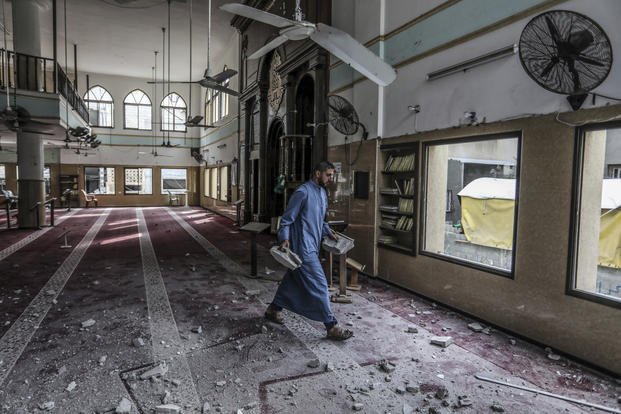

DEIR AL-BALAH, Gaza Strip — Heavy Israeli bombardment shook Gaza City on Tuesday as thousands of fleeing Palestinians searched for shelter and medical facilities were forced to shut down in the latest offensive in the territory’s north.
Israel’s new ground assault in Gaza’s largest city is its latest effort to battle Hamas militants regrouping in areas the army previously said had been largely cleared.
Much of Gaza City and urban areas around it have been flattened or left a shattered landscape after nine months of fighting. Much of the population fled earlier in the war, but several hundred thousand Palestinians remain in the north.
“The fighting has been intense,” said Hakeem Abdel-Bar, who fled Gaza City’s Tuffah district to the homes of relatives in another part of the city. He said Israeli warplanes and drones were “striking anything moving” and that tanks had moved into central districts.
There was no immediate word on casualties. Families whose relatives were wounded or trapped were calling for ambulances, but first responders could not reach most of the affected districts because of the Israeli operations, said Nebal Farsakh, a spokesperson for the Palestinian Red Crescent.
“It’s a dangerous zone,” she said.
After Israel on Monday called for an evacuation from eastern and central parts of Gaza City, staff at two hospitals — Al-Ahli and the Patients Friends Association Hospital – rushed to move out patients and shut down, the United Nations said. Farsakh said all three medical points run by the Red Crescent in Gaza City had closed.
The Israeli military on Tuesday said it had told hospitals and other medical facilities in Gaza City that they did not need to evacuate. But hospitals in Gaza have often shut down and moved patients at any sign of possible Israeli military action, fearing raids.
In the past nine months, Israeli troops have occupied at least eight hospitals, causing the deaths of patients and medical workers along with massive destruction to facilities and equipment. Israel has claimed Hamas uses hospitals for military purposes, though it has provided only limited evidence.
Only 13 of Gaza’s 36 hospitals are functioning, and those only partially, according to the U.N.’s humanitarian office.
Israel’s campaign in Gaza, triggered by Hamas’ Oct 7 attack, has killed or wounded more than 5% of Gaza’s 2.3 million Palestinians, according to the territory’s Health Ministry, and has driven almost the entire population from their homes. Many have been displaced multiple times. Hundreds of thousands are packed into sweltering tent camps.
Maha Mahfouz, a mother of two, said she fled twice in the past 24 hours. She first rushed from her home in Gaza City to a relative’s house in another neighborhood. When that became dangerous, she fled Monday night to Shati, a decades-old refugee camp-turned-urban district.
She described vast destruction in the city’s eastern and central parts. “The buildings were destroyed. The roads were destroyed. All has become rubble,” she said.
Israeli airstrikes in the central town of Deir al-Balah and nearby refugee camps on Tuesday killed at least 14 people, including four children and a woman, according to officials at al-Aqsa Martyrs and al-Awda hospitals, where casualties were taken. One of the strikes hit a police station in an outdoor market in the Nuseirat refugee camp, killing four people and wounding two dozen, half of them women and children. At a hospital, a little boy cried, coughed and wiped his eyes as medics treated him on the crowded floor.
The Israeli military has said it had intelligence showing that militants from Hamas and the smaller Islamic Jihad group were regrouping in central Gaza City. Israel accuses Hamas and other militants of hiding among civilians. In Shijaiyah, a Gaza City neighborhood that has seen weeks of fighting, the military said it had destroyed six kilometers (3 miles) of Hamas tunnels.
Hamas has warned that the latest raids in Gaza City could lead to the collapse of negotiations over a cease-fire and hostage release.
Israel and Hamas had appeared to narrow the gaps in recent days, with the U.S., Egypt and Qatar mediating.
CIA Director William Burns met with Egyptian President Abdel Fattah el-Sissi on Tuesday in Cairo to discuss the negotiations, el-Sissi’s office said. An Israeli delegation was heading to the Egyptian capital, Israeli media reported.
But obstacles remain, even after Hamas agreed to relent on its key demand that Israel commit to ending the war as part of any agreement. Hamas still wants mediators to guarantee that negotiations conclude with a permanent cease-fire, according to two officials with knowledge of the talks.
The current draft says the mediators “will do their best” to ensure that negotiations lead to an agreement to wind down the war. Israel has rejected any deal that would force it to end the war with Hamas intact. Hamas on Monday accused Israeli Prime Minister Benjamin Netanyahu of “putting more obstacles in the way of negotiations.”
Hamas’ cross-border raid on Oct. 7 killed 1,200 people in southern Israel, most of them civilians, according to Israeli authorities. The militants took roughly 250 people hostage. About 120 are still in captivity, with about a third said to be dead.
Israel’s bombardment and offensives in Gaza have killed more than 38,200 people and wounded more than 88,000, according to the territory’s Health Ministry, which does not distinguish between combatants and civilians in its count.
___
Magdy reported from Cairo.
© Copyright 2024 Associated Press. All rights reserved. This material may not be published, broadcast, rewritten or redistributed.
